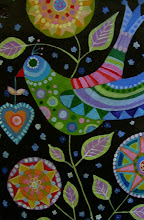Winter landscapes provide a remarkable variety of color - subtle, shifting and almost elusive during the darker days. In this dormant but nonetheless beautiful time of year there is a stillness which leads to inner contemplation and a restfullness after the hectic activity of the previous months.
I was delighted when I ordered some white reindeer leather from my supplier. I had expected it to be really white and brash but instead it is a natural white color with a grey/blue tinge like the reflection of the winter sky on snow. I was reminded of an episode in one of the Clan of the Cave Bear books where Ayla tans some leather to make for her wedding dress. She bleached the leather white by soaking it in urine - nowadays I suspect the principle is the same but probably with a refined form of ammonia rather than raw urine. I had this leather for months not quite knowing what would do with it until now, the icy Northern winter has set in and given me inspiration for this piece of jewelry. I combined sepia colored leather to represent the color of the bare trees on a dark blizzardy day. The pewter wire shines bright like a frosty morning.
Just as I´m writing this a snow blizzard is blowing. This haiku by the master Matsuo Basho is in essence what I´m seeing from my studio window at this moment..
Winter solitude--
in a world of one color
the sound of wind. |





































